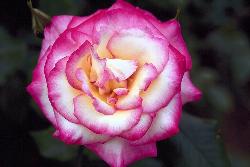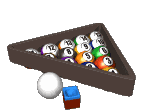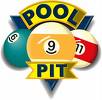BILLIARD vs SNOOKER!!!
@puri_puneet2003 (1220)
India
November 3, 2006 11:21am CST
which game according to u all people is better than the other....
for me its SNOOKER....
what u all think??????
13 responses
@classact (1394)
• India
23 Dec 06
Billiard redirects here. For the long scale number, see billiard (number). For the mathematical theory of billiard trajectories, see dynamical billiards.
This article is about the various cue sports. In English, '"billiards"' often denotes the gamut of cue sports (especially in North American usage). Sometimes, however, "billiards" standing alone will refer in particular to carom games played on a pocketless table, as opposed to "pocket billiards" (or "pool") and "snooker". However, in some dialects, "billiards" always refers unambiguously to a specific game; for instance, in Britain and Ireland, "billiards" denotes "English billiards" exclusively. This article addresses the broadest of these usages, and may use "billiards" or "billiard" generically, as in "billiard balls", to refer to cue sports in general.
A cue sport (sometimes "cuesport") is any game or class of games of the family of cue sports (often generically called "billiards" in American English) — games played indoors with a cue stick which is used to strike balls, moving them around a cloth-covered table bounded by rubber banks (or "cushions").All cue sports are generally regarded to have evolved into indoor games from outdoor stick-and-ball lawn games[1], and as such to be related to croquet and golf, and more distantly to the stickless bocce and bowling. The word "billiard" may have evolved from the French word billart, meaning "mace", an implement similar to a golf club, which was the forerunner to the modern cue. The term "cue sports" generally encompasses the ancestral, pre-cue mace games, and even the modern cueless variant, finger pool, for historical reasons.
Cue sports can be roughly divided into the now rare obstacle category, which appears to have been the earliest[citation needed], and which includes the obsolete bagatelle and pin pool among many other variations, some with elaborate structures (likely inspirational of miniature golf), and yet others on a sloped table (the ancestors of pinball), up to the relatively recent bumper pool (popular in the 1970s in home game rooms). The object of such games varies from avoiding obstructions and traps, to hitting them on purpose to score, to using them strategically to score in some other way, such as by rebounding off them to reach a hole in the table or trapping opponents' balls.[citation needed]
The early croquet-like games eventually led to the development of the carom or carambole billiards category — what most non-US and non-UK speakers mean by the word "billiards" — These games, which once completely dominated the cue sports world but have declined markedly in most areas over the last few generations, are games played with three or sometimes four balls, on a table without holes (or obstructions in most cases, five-pins being an exception), in which the object is generally to strike one object (target) ball with cue ball, then have the cue ball rebound off of one or more of the cushions and strike a second object ball. Variations include straight-rail, three-cushion, balkline variants, Italian five-pins, and four-ball among others.
Over time, a type of obstacle returned, originally as a hazard and later as a target, in the form of pockets, or holes partly cut into the table bed and partly into the cushions, leading to the rise of pocket billiards, especially "pool" games, popular around the world in forms such as eight-ball, nine-ball, straight pool and one-pocket amongst numerous others. The terms "pool" and "pocket billiards" are now virtually interchangeable, especially in the US. English billiards (what UK speakers almost invariably mean by the word "billiards") is a hybrid carom/pocket game, and as such is likely fairly close to the ancestral original pocket billiards outgrowth from eighteenth to early nineteenth-century carom games. Snooker, though technically a pocket billiards variant and closely related in its equipment and origin to the game of English billiards, is a professional sport organized at the international level, and its rules bear little resemblance to those of pool games.
A "Billiards" category encompassing pool, snooker and carom was featured in the 2005 World Games, held in Duisburg, Germany. Efforts have also been under way for many years to have cue sports become Olympic competitions.The number, type, diameter, color, and pattern of billiard balls differ depending upon the specific cue sports game being played. In eight-ball, straight pool, and related games, sixteen balls are employed: fifteen colored "object balls" and one white "cue ball." In most parts of the world, object balls 1 through 7 are solid-colored, and are respectively colored yellow, blue, red, purple, orange, green, and dark red or brown. The 8 ball is solid black. Balls 9 through 15 are white, each with a single wide colored stripe that matches the corresponding solid ball; the 9 ball has a yellow stripe, the 10 ball a blue stripe, and so on. In the game of nine-ball, only object balls 1 through 9 are used. Regulation balls are 2.25 inches (57.15 mm) in diameter and weigh between 5.5 and 6 ounces (156 to 170 g). British pool (not to be confused with the game of English billiards) also uses sixteen balls, but they are not numbered, with the "suits" being divided into reds and yellows instead of stripes and solids (and shots are not "called" since there is no reliable way to identify particular balls to be pocketed); the balls and the pockets on the table are usually slightly smaller, though larger than those of snooker (see below).
Some balls used in televised pool games are colored differently to make them distinguishable on television monitors. The 4 ball used in such games is colored pink instead of purple, while the 7 ball is tan rather than brown. The stripes on the 12 and 15 balls are colored to match, respectively. Cue balls used for televised matches may also depart from the norm, by having multiple spots or stripes on their surface so that spin placed on them is evident to viewers. The spotted variant is coloquially referred to as a "measle ball". Various brands of practice cue ball also have spots, stripes, differently-colored halves or even target-like rings. There is a growing market for speciality cue balls (and even entire ball sets), featuring sports team logos, cartoon characters, etc.
In snooker, there are fifteen red balls, six "colour" balls (yellow, green, brown, blue, pink, and black), and one white cue ball. The red balls are typically not numbered, though the six colored balls often are, especially in the US, and can easily be mistaken at first glance for pool balls. Snooker balls are normally 2-1/16 inches (52.4 mm) in diameter.
In the carom games such as straight-rail (a.k.a. straight rail or one-cushion), three-cushion, and the challenging balkline variations, as well as English billiards, there are two cue balls and a red ball. One of the cue balls is typically white and the other one is either yellow or white with a red dot. These balls are normally 2-7/16 inches (61.5 mm) in diameter.
Various specific ball properties such as hardness, friction coefficient and resilience are very important. Coin-operated pool tables historically have often used either a larger ("grapefruit") or denser ("rock", typically ceramic) cue ball, such that its extra weight makes it easy to separate it from object balls (which are captured until the game ends and the table is paid again for another game) so that the cue ball can be returned for further play, should it be accidentally pocketed. Modern tables usually employ a magnetic ball of regulation or near-regulation size and weight, since players have rightly complained for many decades that the heavy and often over-sized cue balls do not "play" correctly.
The exacting requirements of billiards are met today with balls cast from phenolic resin. Historically, balls were often made of clay, and even ivory for a period. In the mid-ninteenth century, in an uncommon show of accidental environmentalism, the billiard industry realized that the supply of elephants (their primary source of ivory) was limited. They challenged inventors to come up with an alternative material that could be manufactured. John Wesley Hyatt answered the call by inventing cellulose nitrate in 1870, branded under the name celluloid, the earliest industrial plastic. Subsequently, to fix the problem of cellulose nitrate instability, the industry experimented with various other synthetic materials for billiards balls such as bakelite and other plastic compounds. Eventually phenolic resin became the industry standard and is virtually the only billiard ball material used today in tournaments and by the pros. A poorer material called polyester (under various brand names) may also be used, with lower performance and less resistance resulting in shorter ball and cloth lifetimeThere are many sizes and styles of pool and billiard tables. Generally, tables are rectangles twice as long as they are wide. Most pool tables are known as 7-, 8-, or 9-footers, referring to the length of the table's long side. Snooker and English billiard tables are 12 feet long on the longest side. Pool halls tend to have 9-foot tables and cater to the serious pool player. Bars will typically use 7-foot tables which are often coin-operated. Formerly, 10-foot tables were common, but such tables are now considered antique collectors items; a few, usually from the late 1800s, can be found in up-scale pool halls from time to time. 10-foot tables are the standard size for carom billiard games. The slates on modern carom tables are usually heated to stave off moisture and provide a consistent playing surface.
The length of the pool table will typically be a function of space, with many homeowners purchasing an 8-foot table as a compromise. High quality tables are mostly 9-footers, with a bed made of three pieces of thick slate to prevent warping and changes due to h
@kabir_helboy (301)
• India
23 Jan 07
i will prefer snooker. thank you for creating such a discussion and i will also create such interesting discussions in future.

















